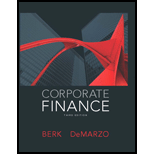
a)
To determine: The WACC for the given current debt-equity ratio.
Introduction:
WACC (weighted average cost of capital) is the rate at which a firm is predicted to pay, on an average, to all the security holders in order to fund its assets.
The debt-equity ratio denotes the amount of debt a firm is utilising to finance its assets, relative to the value of shareholders equity. This ratio is computed by dividing the firm’s total liabilities by its shareholders’ equity; this is used to measure a company’s financial leverage.
b)
To determine: The change in WACC if the cost of capital remains the same but there is an increase in debt-equity ratio.
Introduction:
WACC (weighted average cost of capital) is the rate at which a firm is predicted to pay, on an average, to all the security holders in order to fund its assets.
The debt-equity ratio denotes the amount of debt a firm is utilising to fund its assets, relative to the value of shareholders’ equity. This ratio is computed by dividing a firm’s total liabilities by its shareholders equity; this is used to measure a company’s financial leverage.
c)
To determine: The change in WACC, if it raises the debt-equity ratio to $2.
WACC (weighted average cost of capital) is the rate at which a company is expected to pay, on an average, to all the security holders in order to finance its assets.
The debt-equity ratio denotes the amount of debt a firm is utilising to fund its assets, relative to the value of shareholders’ equity. This ratio is computed by dividing the firm’s total liabilities by its shareholders equity; this is used to measure a company’s financial leverage.
d)
To determine: The difference between solutions in part (b) and (c).
Introduction:
WACC (weighted average cost of capital) is the rate at which a firm is predicted to pay, on an average, to all the security holders in order to fund its assets.
Want to see the full answer?
Check out a sample textbook solution
Chapter 18 Solutions
Corporate Finance
 Essentials Of InvestmentsFinanceISBN:9781260013924Author:Bodie, Zvi, Kane, Alex, MARCUS, Alan J.Publisher:Mcgraw-hill Education,
Essentials Of InvestmentsFinanceISBN:9781260013924Author:Bodie, Zvi, Kane, Alex, MARCUS, Alan J.Publisher:Mcgraw-hill Education,

 Foundations Of FinanceFinanceISBN:9780134897264Author:KEOWN, Arthur J., Martin, John D., PETTY, J. WilliamPublisher:Pearson,
Foundations Of FinanceFinanceISBN:9780134897264Author:KEOWN, Arthur J., Martin, John D., PETTY, J. WilliamPublisher:Pearson, Fundamentals of Financial Management (MindTap Cou...FinanceISBN:9781337395250Author:Eugene F. Brigham, Joel F. HoustonPublisher:Cengage Learning
Fundamentals of Financial Management (MindTap Cou...FinanceISBN:9781337395250Author:Eugene F. Brigham, Joel F. HoustonPublisher:Cengage Learning Corporate Finance (The Mcgraw-hill/Irwin Series i...FinanceISBN:9780077861759Author:Stephen A. Ross Franco Modigliani Professor of Financial Economics Professor, Randolph W Westerfield Robert R. Dockson Deans Chair in Bus. Admin., Jeffrey Jaffe, Bradford D Jordan ProfessorPublisher:McGraw-Hill Education
Corporate Finance (The Mcgraw-hill/Irwin Series i...FinanceISBN:9780077861759Author:Stephen A. Ross Franco Modigliani Professor of Financial Economics Professor, Randolph W Westerfield Robert R. Dockson Deans Chair in Bus. Admin., Jeffrey Jaffe, Bradford D Jordan ProfessorPublisher:McGraw-Hill Education





